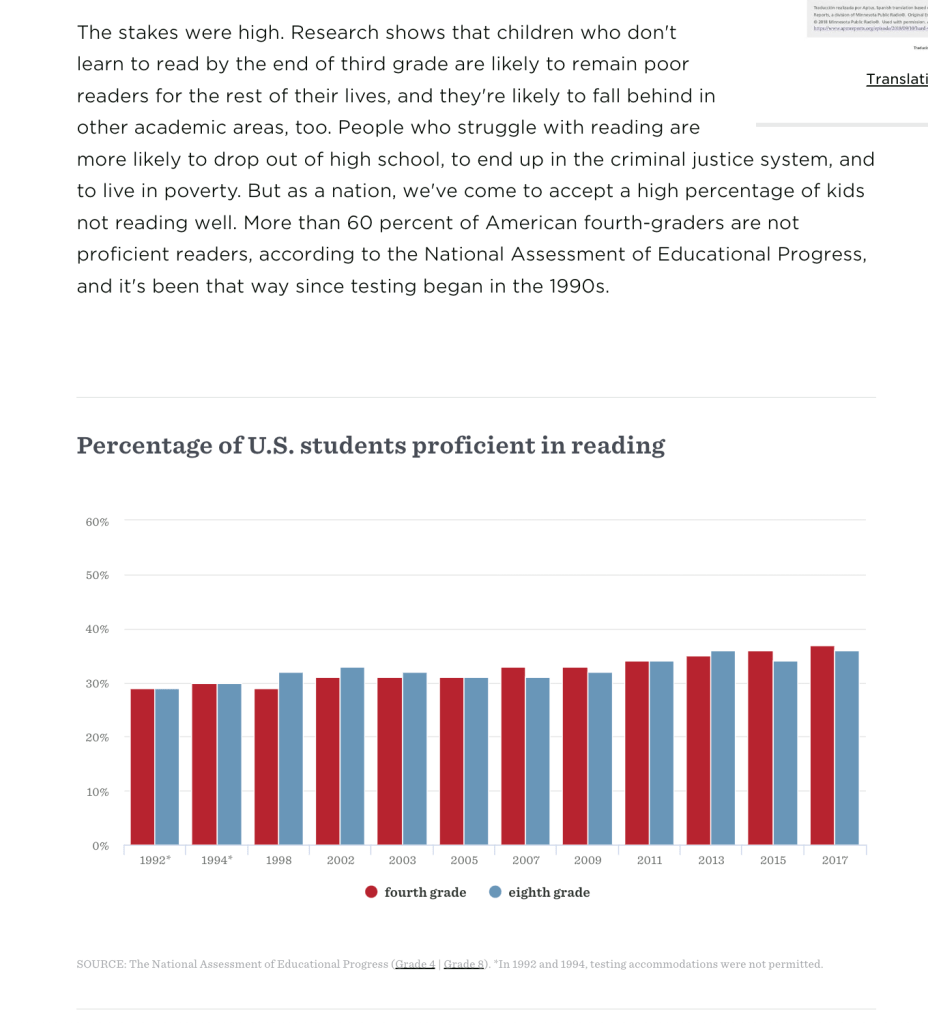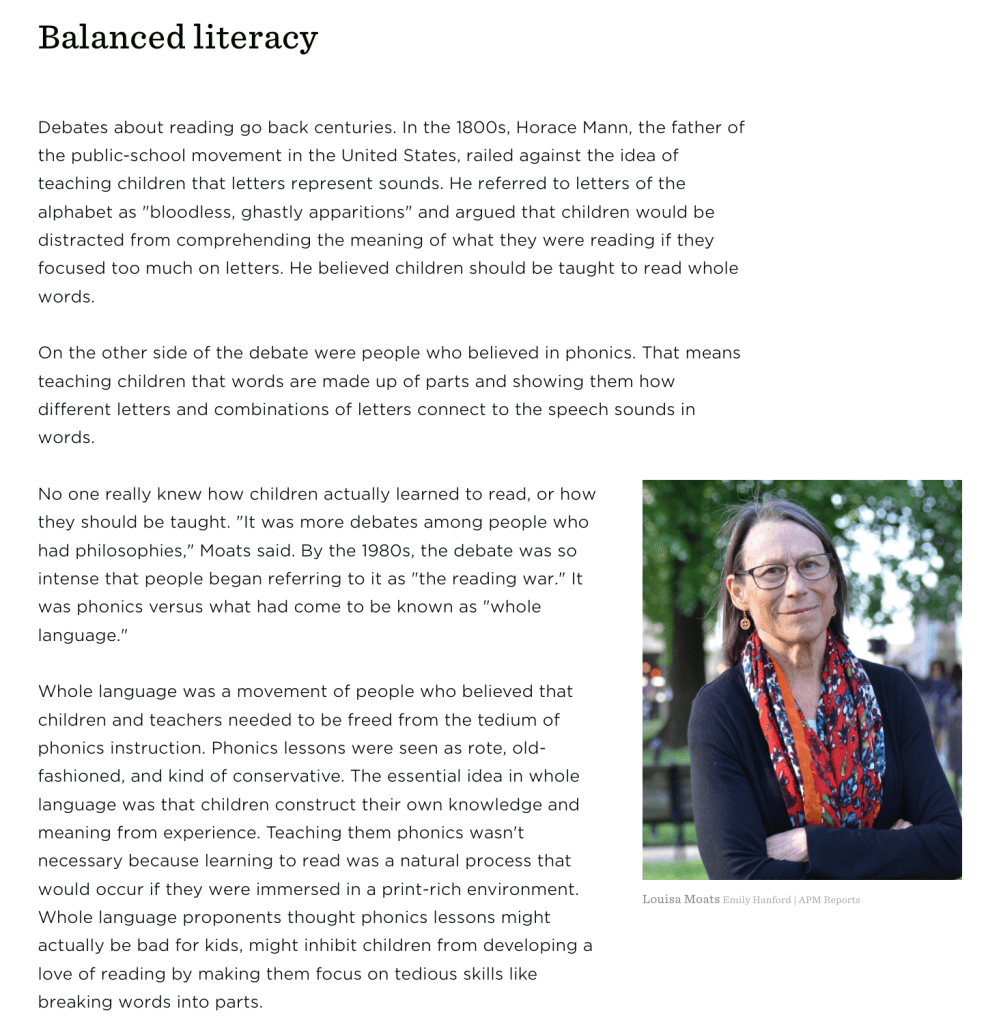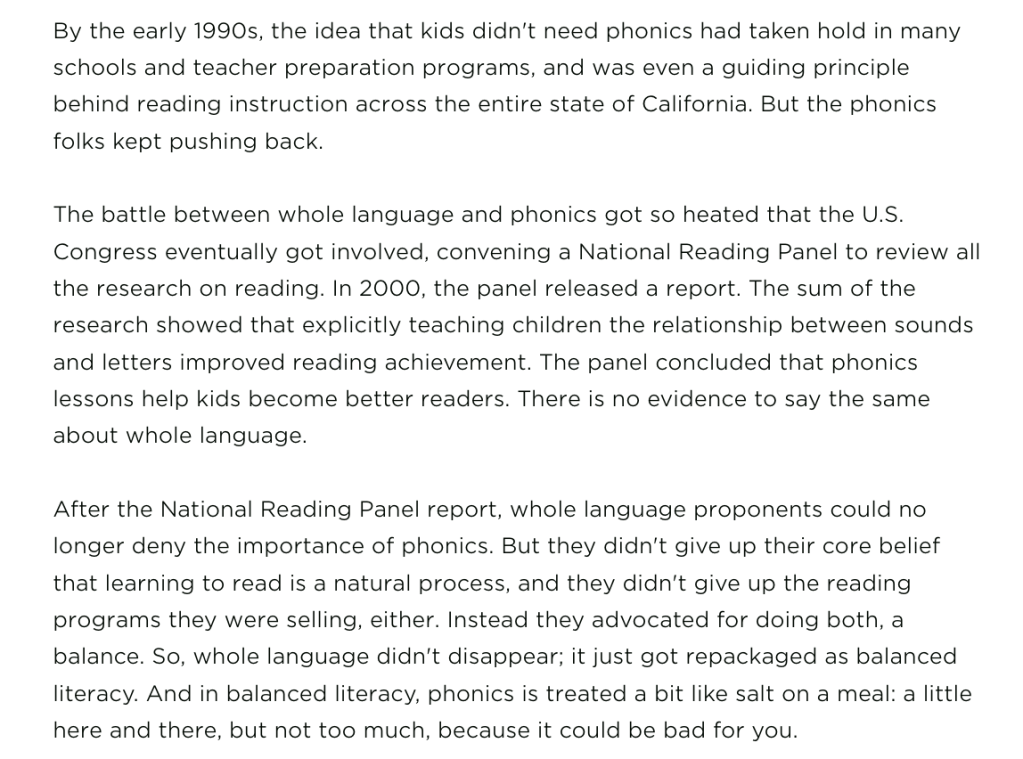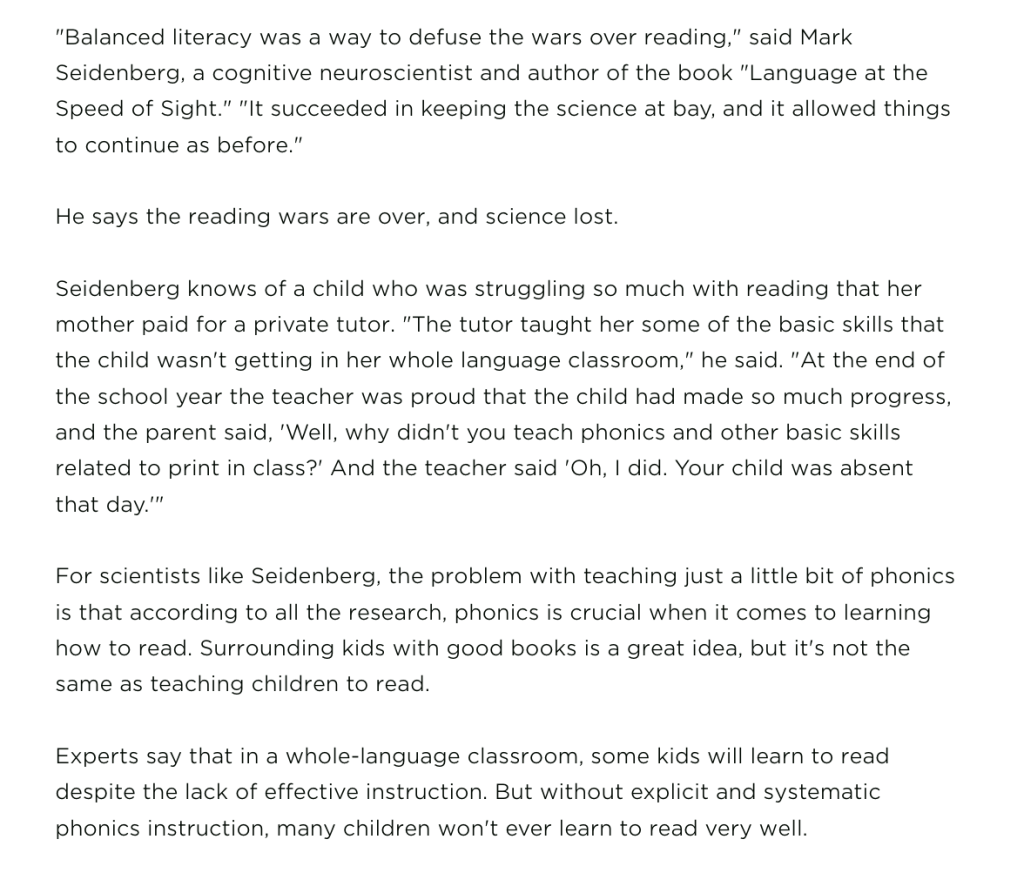The National Children’s Book and Literacy Alliance has a dire message about children and reading in the US:
The 2013 National Assessment of Education Progress (NAEP) reading test results demonstrate that far too many young people continue to read below grade level. Sixty five percent of all U.S. fourth graders scored “below proficient,” which means that they are not reading at grade level. Only 35 percent of fourth graders are reading at or above grade level. In addition, 64 percent of eighth graders are reading below grade level, whereas 36 percent are reading at or above grade level.
Statistics
Doubt this claim? Well, try the NYT and Nicholas Kristof: Two-Thirds of Kids Struggle to Read, and We Know How to Fix It.
Kristof laments: “One of the most bearish statistics for the future of the United States is this: Two-thirds of fourth graders in the United States are not proficient in reading.”
That 2/3 of US children are below grade level reading is a staggering and damning statistic, nearly hard to believe until you do a little simple Googling:
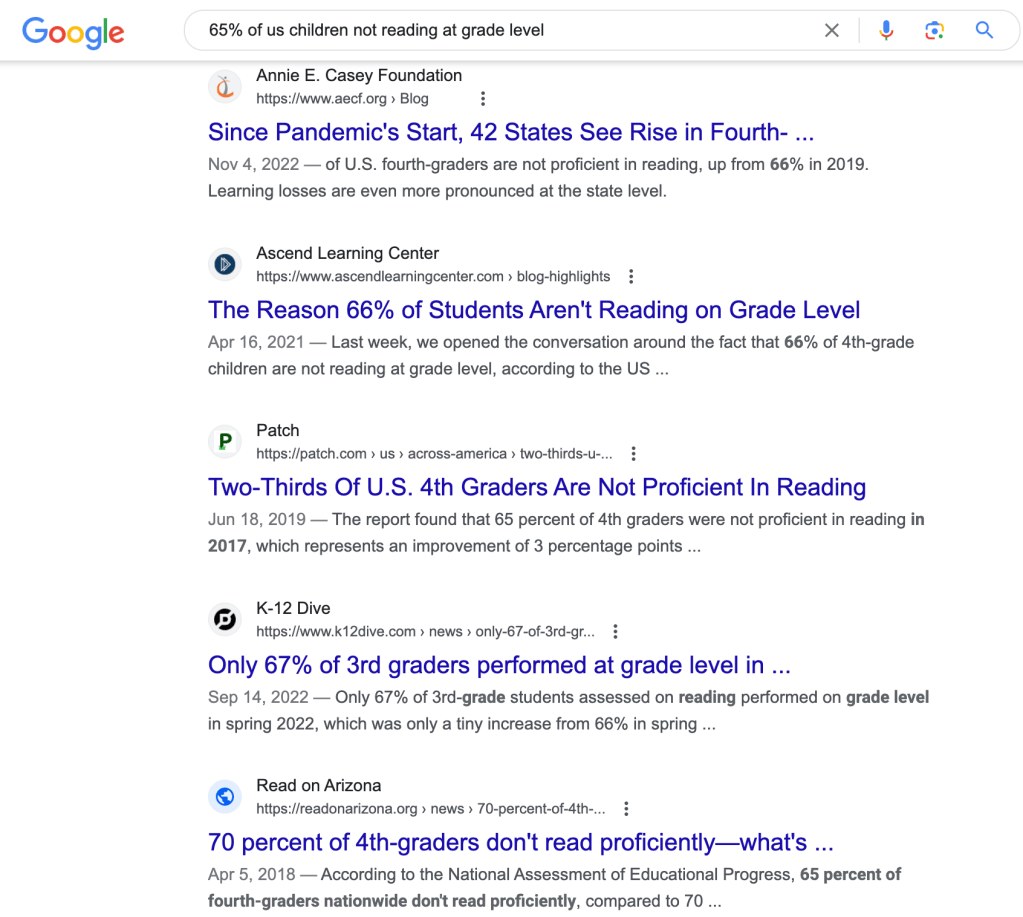
Well, that Googling is a heap of trouble actually. But the message has a consistent core—the use of NAEP reading data to claim that 2/3 of students are not reading on grade level.
But I imagine there is another simple Google search that organizations, parents, journalists, and politicians are not doing:
NAEP student achievement levels are performance standards that describe what students should know and be able to do. Results are reported as percentages of students performing at or above three NAEP achievement levels (NAEP Basic, NAEP Proficient, and NAEP Advanced). Students performing at or above the NAEP Proficient level on NAEP assessments demonstrate solid academic performance and competency over challenging subject matter. It should be noted that the NAEP Proficient achievement level does not represent grade level proficiency as determined by other assessment standards (e.g., state or district assessments). See short descriptions of NAEP achievement levels for each assessment subject.
Scale Scores and NAEP Achievement Levels
While still a complicated statistic and claim, the reality is that if we use NAEP data as evidence, about 2/3 of students in the US read at or above grade level.
That is much different than what has become common knowledge among reading crisis advocates.
As I have explained, grade-level reading proficiency is a problematic statistic that is more grounded in textbook and testing concerns than in supporting student learning or effective teaching.
Especially in the high-stakes accountability era since the 1980s, statistical efforts to evaluate and reform education have made grade-level proficiency increasingly important and a high-stakes aspect of how we treat children in our schools.
One of the most harmful consequences has been the rise in grade retention at grade 3 based on testing data—a policy associated with the Florida Model but currently celebrated in Mississippi.
Grade retention, in fact, has made grade-level proficiency an even more complicated and problematic statistic since retention removes the lowest scoring students from the testing population and then reintroduces them into a grade level one year older than their peers.
States with high levels of retained students often see test scores increase, but those increases may be from students being older and not from any identifiable academic gain (note that many states with increased grade 3 or 4 scores, the gains disappear by middle school).
In fact, test scores are highly correlated with birth months:

Therefore, for testing and especially teaching and learning, grade-proficiency should likely be replaced with age-level proficiency.
Along with shifting from grade-level to age-level proficiency, as the NAEP explanation above reveals, we need to establish a normalized standard for “proficiency.”
And next, we must stop using proficiency levels to punish students:
Grade retention, the practice of holding students back to repeat a grade, does more harm than good:
• retaining students who have not met proficiency levels with the intent of repeating instruction is punitive, socially inappropriate, and educationally ineffective;
• basing retention on high-stakes tests will disproportionately and negatively impact children of color, impoverished children, English Language Learners, and special needs students; and
• retaining students is strongly correlated with behavior problems and increased drop-out rates.
Resolution on Mandatory Grade Retention and High-Stakes Testing
Finally, once we move from grade-level to age-level reading proficiency, create a standard for measuring that proficiency, and stop using proficiency in punitive policy, we have to come to terms with the threshold for proficiency.
One central confusion that persists with testing is the expectation for students meeting or exceeding proficiency at any designated point (grade or age).
One of the greatest flaws in NCLB was the mandate that 100% of students achieve proficiency by 2014. That impossible goal in many ways brought an end to the NCLB era.
However, we are confronted with two problems with setting age-level reading proficiency.
First, if we want age-level proficiency to be attainable by all students at any given age, that standard may be so low as to be pointless.
Next, as is more statistically valid, if we establish age-level reading proficiency where most students can be at or above proficiency, we must come to a social agreement on what percentage below proficiency is acceptable.
Historically with NAEP, that has been about 1/3 of students, which may be evidence that this is normal, even as it causes discomfort in the context of equally compelling and misleading beliefs about the urgency of third grade reading proficiency.
Our current reading crisis is doubling down on the worst aspects of all the previous reading crises as well as the worst elements of education reform.
One way to rise above these historical failures is to understand and then reform reading proficiency as one tool for supporting student achievement and teacher effectiveness.
UPDATE
In an embarrassing promoted Tweet, the University of Florida makes the same false claim about a reading crisis found in media:
The link shows that the program ad is using NAEP data incorrectly (again):
The bookworm is on the verge of becoming an endangered species in America. More than 60% of students in our nation’s K-12 schools can’t proficiently read at their grade levels, and pandemic-related remote learning and a teacher shortage in the past few years have exacerbated the decline. Literacy is in crisis, and the bookworm’s only hope for survival is through fundamental improvements to the entire reading ecosystem.
Seems hard to trust a program at a university that doesn’t understand the data being used to make their claims.
CONTEXT
The “science of reading” movement is mostly journalism, anecdotes, and politics. Note that the movement has its roots in Emily Hanford’s Hard Words, which established misinformation and misunderstanding NAEP, whole language, and balanced literacy.
The evidence used for crisis shows a flat to improving trend line and Hanford’s uses anti-BL sources, Moates and Seidenberg, who have finanacial interests in SOR:
